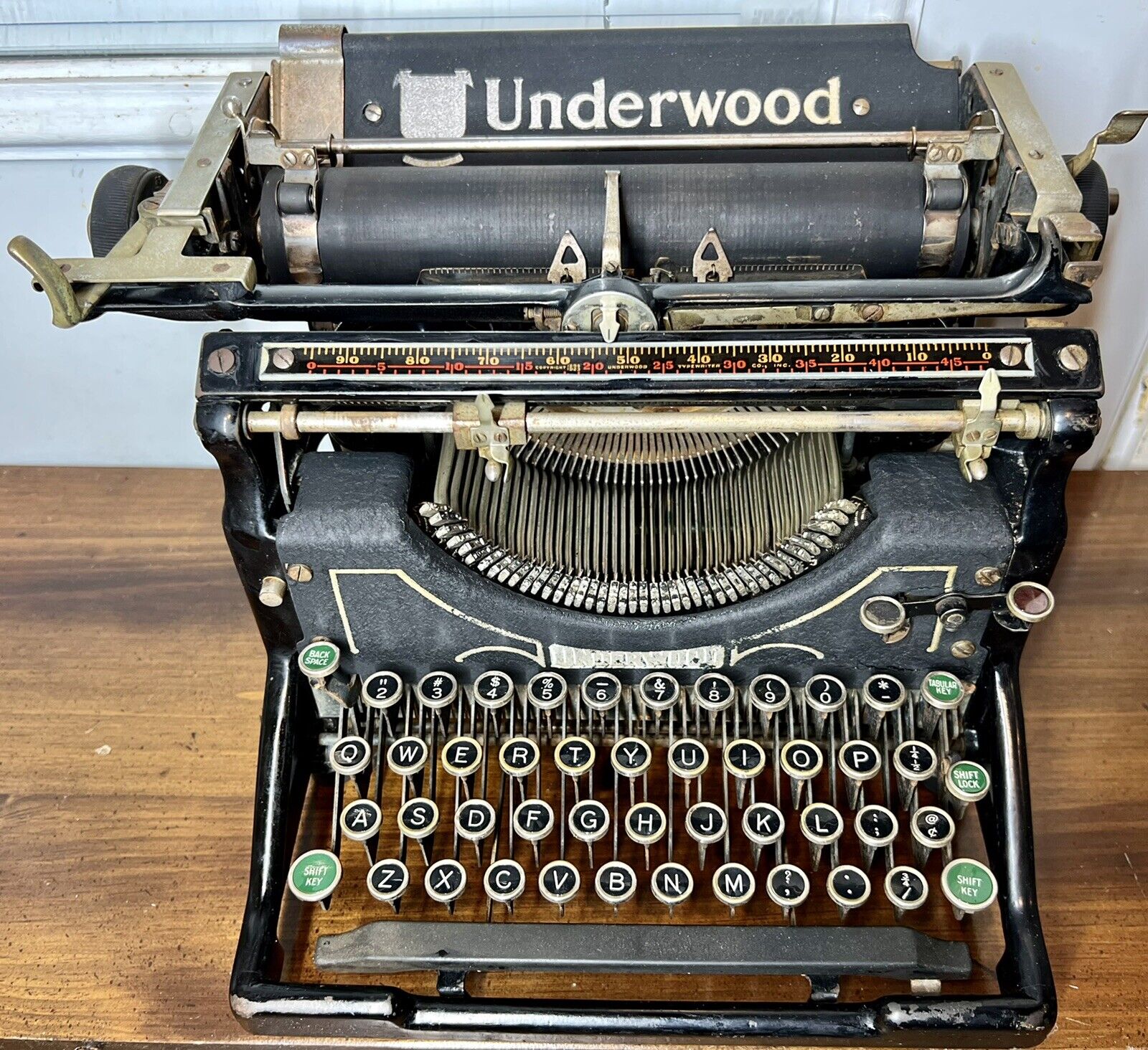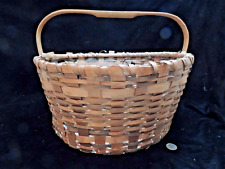When you click on links to various merchants on this site and make a purchase, this can result in this site earning a commission. Affiliate programs and affiliations include, but are not limited to, the eBay Partner Network.
Antique Underwood No. 5 Typewriter
Serial number 2403480-5
All keys strike, but that is the extent of the testing performed.
This typewriter is nearly 100 years old but in good condition for it’s age.
This is your chance to own a true piece of American history!
When most people think "old typewriter," they picture something much like the Underwood No. 5. Why? Because this is the most successful typewriter design in history. Appearing shortly before 1900, the Underwood established the stereotype of a typewriter until the introduction of the IBM Selectric in 1961. When the Underwood was first introduced, it was only one of hundreds of competing and extremely varied typewriter designs. But by 1920, almost every typewriter imitated the Underwood.
The Underwood typewriter is the creation of German-American inventor Franz X. Wagner. The name "Underwood" comes from John T. Underwood, an entrepreneur who bought the company early in its history. (The Underwood family was already a successful manufacturer of ribbons and carbon paper. It's said that when Remington decided to produce its own line of ribbons and carbon paper, Underwood responded, "All right, then, we'll just build our own typewriter!")
The scarcest and most valuable Underwoods are the No. 1 and No. 2. About 12,000 of these were made between 1896 and 1900. They are labeled "Wagner Typewriter Co." on the back, and differ in subtle ways from later Underwoods. One difference is the absence of the see-saw ribbon color selector that you can see on the right side of the machine pictured at the top of this page.
Underwood Models 3, 4, and 5 were made from late 1900 until late 1931 or early 1932. The No. 3 is a wide-carriage machine, the No. 4 types 76 characters, and the No. 5 types 84 characters. The No. 5 was the quintessential Underwood. Millions of these machines were used by secretaries, journalists, government officials, and writers throughout the first half of the twentieth century. Later Underwoods were superficially modernized, but retained the same basic mechanism. The name "No. 5" was even given to some of these later typewriters, in honor of the model that made the company's fortune. The company was eventually bought by Olivetti, and in the early 1960s, the name "Underwood" finally disappeared from the typewriter world.
Now, why was the Underwood so successful in its day? Let's review the advantages and disadvantages of the Underwood as compared to other designs:
Typebars. Typebar typewriters were always popular, but many early typewriters printed from single type elements (typewheels, type cylinders, or type shuttles). Single-element typewriters have excellent alignment, and offer the convenience of interchangeable type styles. But typebar typewriters won out--temporarily--because they were faster. This difference in speed was remedied only by the electrified IBM Selectric, with its "golf ball" type element. In order to maintain relatively good alignment, the Underwood's typebars pass through a U-shaped slotted segment.
Frontstroke mechanism. As this ad from 1906 points out, writing on the Underwood is in sight, because the typebars hit the front of the platen. That may sound obvious, but most typebar machines of the 1870s-1890s were understrokes: these "blind writers" typed on the bottom of the platen, and the typist had to raise the carriage in order to see what she had just typed. There were many attempts to solve this problem, but the frontstroke approach was probably the best. (The Underwood was not the first frontstroke machine; it was preceded by the Daugherty, among others.)
QWERTY keyboard. This awkward arrangement of letters was introduced on the Sholes and Glidden of 1874. Many manufacturers introduced competing arrangements, but QWERTY won out, by force of habit. Underwood was wise not to introduce a different arrangement.
Four-bank keyboard with single shift. Some other typewriters used "full keyboards," with a separate key for each character. Others had only three banks of keys, and two shifts (one for capitals, one for numerals and symbols). Some cheap "index" typewriters didn't have keyboards at all. But the four-bank, single-shift arrangement was found to be best for touch typing. Once again, considerations of speed were most important.
Ribbon inking. Some other typewriters employed ink rollers or ink pads. The advantage of such a system is that it types very neatly, whereas cloth ribbons create a blurry impression. But ribbons are a little easier to care for, and need to be replaced less often. (Smith-Corona introduced one of the best solutions in the 1960s: a cartridge holding a single-use plastic ribbon.)
When we consider all these features, we can see that the Underwood was a compromise. It was inferior to other designs in certain respects, but on the whole, it served the needs of the market well. It's unfortunate that the Underwood and its imitators drove hundreds of competitors to extinction. After the turn of the century, the diversity of species in the typewriter kingdom would never again reach the level of the 1890s.
If you have an Underwood No. 5, you should enjoy its nearly-indestructible workmanship, classic design, and historic significance. You should type on it, just to experience what it was like to be a typist in the days before electric typewriters and computers.
Underwood Typewriter Company
The Underwood Typewriter Company was an American manufacturer of typewriters headquartered in New York City, with manufacturing facilities in Hartford, Connecticut. Underwood produced what is considered the first widely successful, modern typewriter. By 1939, Underwood had produced five million machines.
From 1874, the Underwood family made typewriter ribbon and carbon paper, and were among a number of firms who produced these goods for Remington. When Remington decided to start producing ribbons themselves, the Underwoods opted to manufacture typewriters.
The original Underwood typewriter was invented by German-American Franz Xaver Wagner, who showed it to entrepreneur John Thomas Underwood. Underwood supported Wagner and bought the company, recognizing the importance of the machine.
The Underwood Number 5 launched in 1900 has been described as "the first truly modern typewriter." Two million of these typewriters had been sold by the early 1920s, and its sales “were equal in quantity to all of the other firms in the typewriter industry combined.” When the company was in its heyday as the world's largest typewriter manufacturer, its factory in Hartford, Connecticut was turning out typewriters at the rate of one each minute and, along with Royal Typewriter Company, made Hartford the “Typewriter Capitol of the World”.
Philip Dakin Wagoner was appointed president of the Elliott-Fisher Company after World War I (1914-1918). Elliott-Fisher became the parent of the Underwood Typewriter Company and the Sundstrand Adding Machine Co. In 1927 Wagoner reorganized the company into Underwood-Elliott-Fisher, which later became the Underwood Corporation. The reorganization was completed in December 1927. John Thomas Underwood was elected chairman and Wagoner president of Underwood Elliott-Fisher.
In the years before World War II, Underwood built the worlds' largest typewriter in an attempt to promote itself. The typewriter was on display at Garden Pier in Atlantic City, New Jersey, for several years and attracted large crowds. Often, Underwood would have a young woman sitting on each of the large keys. The enormous typewriter was scrapped for metal when the war started.
During World War II, Underwood produced M1 carbines. Approximately 540,000 M1 carbines were produced from late 1942 to May 1944. Underwood also produced M1 carbine barrels for the U.S. government. Under the Free Issue Barrel Program, barrels were sent to other prime manufacturers who did not possess the machines to make barrels.
In 1945 Wagoner was elected chairman of the board of Underwood, and Leon C. Stowell was elected president. Wagoner remained chief executive. Olivetti bought a controlling interest in Underwood in 1959, and completed the merger in October 1963, becoming known in the U.S. as Olivetti-Underwood with headquarters in New York City, and entering the electromechanical calculator business. The Underwood brand appears in 2021 on some cash registers produced by Olivetti.









